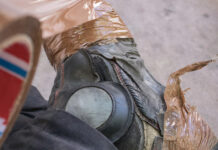Working on a construction site poses many hazards. Dropped tools – or other objects – can cause serious injuries & even fatalities for those down below. We’re well into our National Safety Month tribute, & this week we’re focusing on staying protected from falling objects. The Bureau of Labor Statistics tells us that there are more than 50,000 “struck by falling object” events recorded every year in the United States. Learn how to minimize your risk of injury or death from falling objects on the job.
How can you prevent injuries and fatalities from falling objects?
Both employers & employees play important roles in preventing injuries caused by falling objects. The Occupational Safety and Health Administration (OSHA) has several guidelines for environments where there are risks of falling objects:
- Secure tools & materials to prevent them from falling on people below
- Barricade hazard areas & post warning signs
- Use toe boards, screens on guardrails, or scaffolds
- Use debris nets, catch platforms, or canopies to catch or deflect falling objects
Hard Hats 101
OSHA tells us that workers must wear a protective helmet when working in areas where there’s a potential for injury to the head from falling objects. The hard hat you choose needs to comply with the American National Standards Institute (ANSI) Z89.1-2009, “American National Standard for Industrial Head Protection” standard. Each helmet needs to have a shell & suspension system (such as a headband). The suspension’s job is to absorb the shock of a blow to the top of the hard hat; it needs to be adjustable to prevent the helmet from falling off of your head.
Proper care of your hard hat will help you ensure it’s doing its job to keep you safe. Giving your hat’s shell & suspension routine inspections will help you maintain its efficiency. When inspecting the shell, Occupational Health & Safety Magazine recommends to look for cracks, nicks, dents, gouges, & any damage caused by impact, penetration, abrasions, or rough treatment. If your hat is made of thermoplastic materials, look for stiffness, brittleness, fading, dullness of color, or a chalky appearance. If you see any of these signs of wear, it’s time to remove the shell & replace it immediately.
When inspecting the suspension, look closely for cracks or tears, frayed, or cut straps, loss of pliability, or other signs of wear. All keys of your suspension keys should fit tightly & securely into their slots. If it shows signs of damage, remove the suspension immediately & replace it. If you’re in doubt about the quality of your hard hat, contact the manufacturer.
At Working Person’s Store we offer a wide variety of hard hats to keep workers safe. If you’re looking for special features, like cooling pads, we can help. We also carry many different designs – from classic to cowboy – so you can find the one that’s right for you.
Staying safe from falling objects takes active participation from employers & employees. Do your part to minimize this hazard at your workplace by following safety guidelines & always wearing protective head wear.





